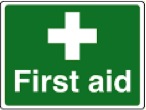
Farming men, women, children and agricultural workers are exposed to many hazards which can potentially cause trauma and injury, resulting in bleeding. Bleeding may present as minor bleeding from small cuts, abrasions and nosebleeds or severe external or internal bleeding caused by trauma. Bleeding always requires immediate attention and first aid.
- First aid for severe external bleeding includes applying direct pressure on the wound maintained by using preferably clean pads and bandages, and raising the injured area above the level of the heart if possible.
- First aid for internal bleeding assist into comfortable position. If suffering breathing difficulties – sit in an upright position. If no breathing difficulties raise legs above the level of the heart. Cover with a blanket but DO NOT overheat and protect from the external environment. DO NOT give food or drink.
- First aid for small cuts and abrasions can be treated at home. Clean the area of the wound, disinfect and apply a clean bandage or sticking plaster.
- Having a well-stocked first aid kit available is your responsibility. Keep several first aid kits around the farm, for example in the workshop, shearing shed and in the tractor.
To find out more on the different types of bleeding, treatment and management. Go to Better Health Channel
Severe bleeding, which doesn’t stop after 10 minutes of continuous pressure, requires urgent medical attention. Call triple zero (000).
Fast facts:
- First aid for external bleeding is critical to limit blood loss.
- Apply and maintain direct pressure on the wound. Use pads, bandages, or anything available like towels or a t-shirt if you are not near a first aid kit.
- For external bleeding – raise the injured area above the level of the heart if you can.
- For internal bleeding – place the injured in a comfortable position. Keep warm and DO NOT offer food or drink.
- If severe bleeding continues after 10 minutes of continuous pressure call triple zero (000) and give a clear description of your location and emergency situation. Remain calm, stay focused, and reassuring to the injured person.
- Always have more than one person trained in First Aid on your farm and family.
References used for this topic
More information:
Better Health Channel
Bleeding
St John Ambulance NSW
Managing severe bleeding
Worksafe Compliance code: First aid in the workplace
Clinical care:
National Blood Authority Australia
Patient Blood Management Guidelines
|
|